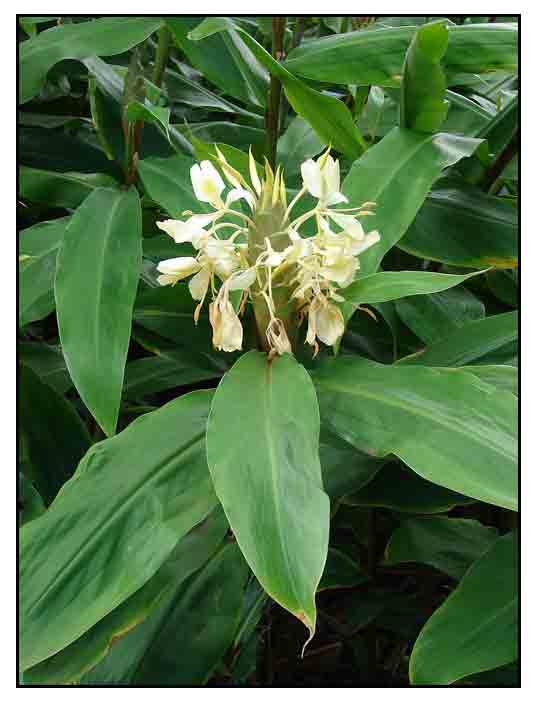 Botany Botany
Hedychium flavescens is a robust perennial herbaceous herb with leafy shoots growing 1 to 3 meters high. Rhizomes are large and branching, thick and fleshy, up to 3.5 centimeters in diameter. Leaves are stiff, green sessile, oblong to lanceolate, up to 60 centimeters long, and 12 centimeters wide. Flowers are fragrant, inflorescences erect, up to 20 centimeters long, 8 centimeters wide, loosely imbricate, with a yellowish corolla, and staminodal tip that is obcordate, claw-like, reddish yellow at base. Fruits are globular capsules with three valves, containing many seeds.
Distribution
- Introduced as an ornamental for its fragrant flowers.
-
Probably escaped cultivation.
- Growing at the edge of forests in Bukidnon and other low altitudes areas in Mindanao.
- Native to the HImalayas.
- Also occurs in China, India, and Nepal.
- In some places in Hawaii, New Zealand, and Madeira, considered an invasive weed.
Constituents
- Phytochemical screening of rhizome yielded carbohydrates, starch, sugar, protein, cardiac glycoside, phenols, saponins, alkaloids, tannin, phlobatannin, and terpenoids. Flowers yielded carbohydrates, ketose protein, phenols, saponins, and terpenoids. (7)
- GC-MS study for essential oil showed ß-pinene (43.6%) as the most abundant constituent. Sesquiterpene contents was 0.6%. (8)
Properties
- Essential oil has shown central nervous system tranquilizing effects and anthelmintic activities.
-
Studies have shown antiproliferative, aantibacterial, antifungal, mosquito repellent properties.
 Parts used Parts used
Stems, rhizomes.
Uses
Edibility
- Young buds and flowers eaten or used as flavoring.
Folkloric
- In the Philippines, base of stem is chewed or drunk as decoction for tonsilitis. (4)
- In the Moluccas, juice from the stem applied as remedy for swellings. (4)
- In Comoros, Africa, crushed rhizomes used to treat fractures. (6)
- In India, rhizomes used by tribal groups of Bijar as febrifuge, antirheumatic, tonic and stimulant. (7)
- In Manipur, India, rhizomes used for treatment of various skin infections. Boiled extract of rhizome wiith Meitei thum (local common salt) used as gargle for throat swellings and also taken orally for abdominal swellings, colic, and hemorrhoids. Crushed extract of fresh rhizome used with honey for chest oongestion, cough, asthma, and bronchitis. (11)
Others
- Perfumery: Distilled flower oil used as perfume precursor.
Studies
• Coronarin D / Antiproliferative / Anticancer: Study isolated coronarin D from dried, powdered rhizomes of H. flavescens. Coronarin D was shown to have antiproliferative proapoptotic, anti-invasive, antiangiogenic, antiosteoclastogenic, and anti-inflammatory effects through suppression of NF-kB and NF-kB-regulated gene products.
• Antimicrobial / Rhizomes: Study of essential oil of
rhizomes for antimicrobial activity by disc diffusion showed strong antibacterial activity against Salmonella typhi, Escherichia coli, and Proteus vulgaris, and antifungal activity against Candida albicans and C. glabrata with zones of inhibition of 23 mm, 18 mm, 15 mm, 13 mm, and 14 mm, respectively. (9)
• Mosquito Repellent / Oil: In Mosquito Repellency assays, H. flavescens showed potent mosquito repellent activity (0.164 ± 0.023). (10)
Availability
Wild-crafted.
|

![]()



 Botany
Botany Parts used
Parts used